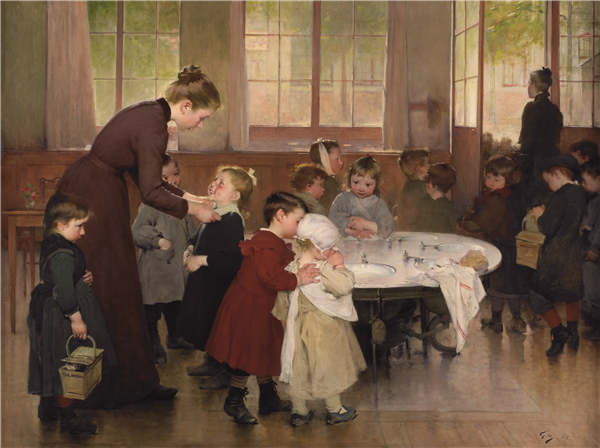 |
|
Nursery School by Henri Jules Jean Geoffroy. [Photo provided to China Daily] |
Philippe Cinquini, the exhibition's French curator, says it is rare for two Parisian institutions to come together for an event like this.
The exhibition also marks the China debut of three important paintings by Jean-Auguste-Dominique Ingres (1780-1867)-Male Torso, The Envoys of Agamemnon and Jupiter and Thetis.
Ingres, a French neoclassic painter, is famed for painting portraits, especially nudes.
The first two pieces are from Beaux-Arts de Paris' collection and were both exhibited at the Exposition Universelle of 1889 in Paris. while the third one is from CNAP and has been on display since 1835 at the Musee Granet in the southern city-commune Aix-en-Provence.
In another significant departure from the norm where paintings at exhibitions are typically displayed separately, the ongoing show has some of the works placed unevenly in two or three decks, which Cinquini says was the way that paintings were arranged in salons of 19th-century Paris. It is still how works are exhibited at the Beaux-Arts de Paris today.
Cinquini also says important artists of the 19th-century like Ingres are at the heart of this exhibition.
"The 19th century was a century of art," Cinquini says. "Also it was a century of advancing science and democracy, which was mirrored in artistic creation."
Among the other significant works on show is Andre Brouillet's A Clinical Lesson at the Salpetriere Hospital from the CNAP collection.
The work is a tableau portrait of a neurologist giving a demonstration.
The piece is widely considered one of the best known artistic depictions of medicine, and Cinquini says it shows the interaction between science and art, as among the participants in the lesson is Paul Richer, an anatomist and sculptor.
Ricer was a professor of artistic anatomy at Beaux-Arts de Paris whose class was attended by Chang Shuhong.
The exhibition also focuses on how art academies, competitions and public collections piloted creation and supported artists, by showcasing works which were winners of the Grand Prix de Roma.
The prize and scholarship established in the 17th century allowed promising artists to stay in Rome for three to five years at state expense.
The exhibition also highlights the role of CNAP in collecting art.
Anne-Sophie de Bellegarde, general secretary of CNAP, says the institution was founded in 1791 during the French Revolution, when France established a system of public purchase and collection of art.
She says CNAP manages a holding of artworks that is "without a fence".